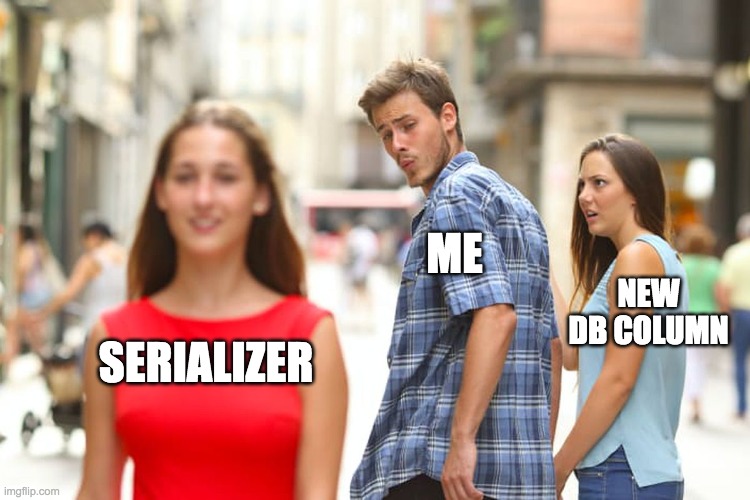
Last time we left off with a bunch of failing specs, so lets begin. Our most pressing issue right now is that we’re trying to test our requests against routes that don’t exist. So that’s a good place to start.
Rails.application.routes.draw do
resources :links
resources :redirect
get '/s/:slug', to: 'redirects#index'
end
Now we can take a look at our new routes
$ rails routes
Just beautiful. Now we have a list of all of the endpoints available to us. Not that they do anything mind you, but patience is a virtue.
…A virtue I don’t have, here’s the links controller
class LinksController < ApplicationController
before_action :set_link, only: %i[show update destroy show]
def index
@links = Link.all
json_response(@links)
end
def show
json_response(@link, :ok)
end
def create
@link = Link.new(link_params)
@link.update_attribute(:slug, generate_slug(link_params[:slug]))
return json_response(@link, :created) if @link.save
json_response({ message: @link.errors.first }, :unprocessable_entity)
end
def update
@link.update(link_params.except(:slug))
@link.update_attribute(:slug, generate_slug(link_params[:slug])) if link_params[:slug]
return json_response(@link, :ok) if @link.save
json_response({ message: @link.errors.full_messages }, 422)
end
def destroy
@link.delete
json_response({ message: Message.deleted_link }, :ok)
end
private
def set_link
@link = Link.find(link_params[:id])
json_response({ message: Message.not_found('link') }, :not_found) unless @link.present?
end
def link_params
params.permit(:slug, :url, :id)
end
def generate_slug(slug_param = nil)
slug = slug_param || SecureRandom.uuid[0..5]
# if slug is taken add random characters to the end
Link.find_by(slug: slug) ? slug.concat(SecureRandom.uuid[0..2]) : slug
# if slug is still taken call self again
Link.find_by(slug: slug) ? generate_slug(slug_param) : slug
end
end
and redirects
class RedirectsController < ApplicationController
before_action :set_link
def index
@link.update_attribute(:clicked, @link.clicked + 1)
redirect_to @link.url
end
private
def set_link
@link = Link.find_by(slug: link_params[:slug])
json_response({ message: Message.not_found('link') }, :not_found) unless @link.present?
end
def link_params
params.permit(:slug)
end
end
Notice the next helper json_response. This nifty little method will do just what it says on the tin. It will send a json response containing a message and a response code.
module Response
def json_response(object, status = :ok)
render json: object, status: status
end
end
and finally reference this in our application controller so we can access it in our controllers
class ApplicationController < ActionController::API
include Response
end
Lets see what this puppy can do, I’m using a handy little tool called httpie to make requests. with zero effort. I will happily say goodbye to curl.

now that’s just cool. The rest of the endpoints should work too.
# GET /links
$ http :3000/links
# POST /links
$ http POST :3000/links url=google.ie slug=google
# PUT /links/:link_id
$ http PUT :3000/links/1 url=google.com
# DELETE /links/:link_id
$ http DELETE :3000/links/1
with our endpoints looking fly, we’re almost done. One very important thing we need to consider is versioning. Our controller works great, but do did horses in the 1800s. We can make a pretty safe bet that in the future we’ll want to try something new. And changing our api endpoints could break functionality for other people using our api. Lets talk versioning.
A great way to make sure we always have room to expand our functionality without removing what’s currently there is versioning. Lets say our current api is v1 and make it the default version. Then we can create a second version, and only use it when we ask for it.
lets give it a go.
lets create a class called ApiVersion that will check requests coming in for the version, and act accordingly.
$ touch app/lib/api_version.rb
class ApiVersion
attr_reader :version, :default
def initialize(version, default = false)
@version = version
@default = default
end
# check whether version is specified or is default
def matches?(request)
check_headers(request.headers) || default
end
private
def check_headers(headers)
# check version from Accept headers; expect custom media type `links`
accept = headers[:accept]
accept&.include?("application/vnd.links.#{version}+json")
end
end
so, according to the Media Type Specification, you can define your own media types using the vendor tree i.e. application/vnd.example.resource+json.
We’re going to follow this specification for our api. Here we define a custom vendor media type application/vnd.links.{version_number}+json giving clients the ability to choose which API version they require. No need to add /v2/ to the url. Pretty cool right.
Now we can go ahead and update our routes to have multiple versions
Rails.application.routes.draw do
# namespace the controllers without affecting the URI
scope module: :v1, constraints: ApiVersion.new('v1', true) do
resources :links
resources :redirect
get '/s/:slug', to: 'redirects#index'
end
end
We’ve set the version constraint at the namespace level. Handily, this will be applied to all resources within it. We’ve also defined v1 as the default version for cases where the version is not provided, the API will default to v1.
In the event we were to add new versions, they would have to be defined above the default version since Rails will just cycle through all routes from top to bottom searching for one that matches(till method matches? resolves to true).
lets give our controllers a new home
$ mkdir app/controllers/v1
And move them in
$ mv app/controllers/{links_controller.rb,redirects_controller.rb} app/controllers/v1
That’s not all, lets define the controller in the v1 namespace
module V1
class linksController < ApplicationController
# [...]
end
end
and the redirectsController
module V1
class RedirectsController < ApplicationController
# [...]
end
end
Now lets take a beat and see what works and what doesn’t
# get links from API v1
$ http :3000/links Accept:'application/vnd.links.v1+json'
# attempt to get from API v2
$ http :3000/links Accept:'application/vnd.links.v2+json'
In case we attempt to access a nonexistent version, the API will default to v1 since we set it as the default version. For testing purposes, let’s define v2.
Generate a v2 links controller
$ rails g v2/links
define a namespace
#config/routes.rb
Rails.application.routes.draw do
# For details on the DSL available within this file, see http://guides.rubyonrails.org/routing.html
# module the controllers without affecting the URI
scope module: :v2, constraints: ApiVersion.new('v2') do
resources :links, only: :index
end
scope module: :v1, constraints: ApiVersion.new('v1', true) do
# [...]
end
# [...]
end
Since this is test controller, we’ll define an index controller method with a dummy response.
module V2
class LinksController < ApplicationController
def index
json_response({ message: 'Its always important to version an API' })
end
end
end
Note: ruby will generate the shorthand for our class structure
class V2::LinksController < ApplicationController
you can use either or, I prefer the long hand.
Great! now lets fire out some tests
# get links from API v1
$ http :3000/links Accept:'application/vnd.links.v1+json'
# attempt to get from API v2
$ http :3000/links Accept:'application/vnd.links.v2+json'
looking good.
Optional Extra:
This is where I was going to call it a day, but I’ve had my coffee and am feeling generous. So lets do a BONUS ROUND!
I can see that we return the slug and the url but not them together. We could make a record in the table and save them combined, but then again we already have them. So what else can we do?

Lets go ahead and add the rails serializer gem
gem 'active_model_serializers', '~> 0.10.0'
bundle it
$ bunde install
Generate the serializer for the link model
$ rails g serializer link
This creates a new directory app/serializers and adds a new file link_serializer.rb. Let’s define the link serializer with the data that we want it to contain.
class LinkSerializer < ActiveModel::Serializer
attributes :id, :url, :slug, :created_at, :updated_at, :short
end
What’s that there? I don’t remember our link model model having an attribute called short. Well look again!
# frozen_string_literal: true
class Link < ApplicationRecord
before_validation :format_url
validates_presence_of :url
validates_presence_of :slug
validates_uniqueness_of :slug
validates :url, format: URI::DEFAULT_PARSER.make_regexp(%w[http https])
validates_numericality_of :clicked
validates_length_of :url, within: 3..255, on: :create
validates_length_of :slug, within: 1..255, on: :create
def format_url
return false unless url.present?
self.url = "http://#{url}" unless url[%r{\Ahttp://}] || url[%r{\Ahttps://}]
end
def short
url = Rails.env.development? ? 'localhost:3000/s/' : 'example.com/'
url + slug
end
end
Now lets see if we can get our link

well

Conclusion
We now have a rails 6 api, complete with a full test suite, serializers and a beautifully versioned api. Not too shabby.
We’ve come a long way, and we’ve achieved so much. Stay tuned for the next part where I either:
- Implement Users & JWT authentication
- Dockerize the application
- Create a front end using Vue.js
- Leave this repo to collect dust in github
Email me your votes.